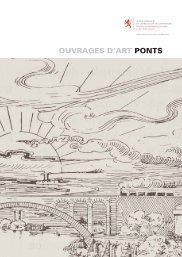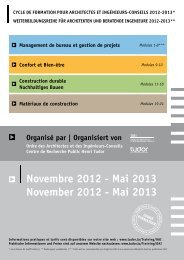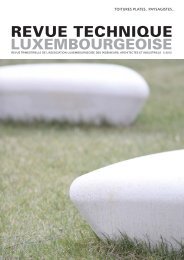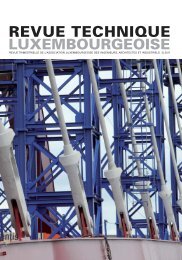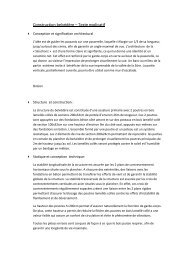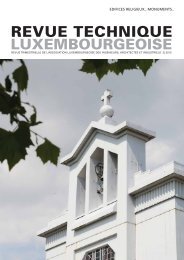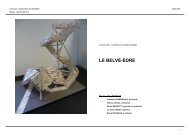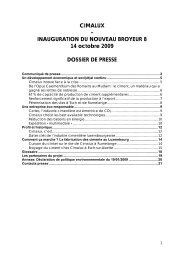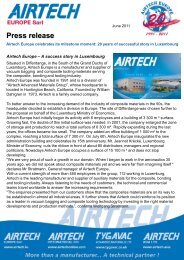40 YEARS OF DELPHI IN LUXEMBOURG - Revue Technique ...
40 YEARS OF DELPHI IN LUXEMBOURG - Revue Technique ...
40 YEARS OF DELPHI IN LUXEMBOURG - Revue Technique ...
Create successful ePaper yourself
Turn your PDF publications into a flip-book with our unique Google optimized e-Paper software.
8 HORS SERIE #002 | REVUE TECHNIQUE <strong>LUXEMBOURG</strong>EOISE<br />
_1999 An Independent Delphi<br />
On Aug. 3, 1998 General Motors Corporation and its Delphi<br />
Automotive Systems division jointly decided to make<br />
Delphi an independent group. Delphi became a publicly<br />
traded company in 1999. But the path to independence<br />
from General Motors really began in 1994 with the establishment<br />
of Delphi as a separate business sector within<br />
General Motors.<br />
_Jan. 29, 2007 - Delphi Powertrain Headquarters Grand<br />
Opening<br />
In May 2006, Delphi announced its decision to relocate<br />
the global headquarters of its Powertrain division to Luxembourg.<br />
Delphi Corporation officially opened the global<br />
headquarters of its Powertrain division in Luxembourg on<br />
Jan. 29, 2007. “We are dispersing our leadership globally to<br />
manage our business”, Delphi’s Executive Chairman said at<br />
the time. “We are committed to Europe and to supporting<br />
our local customers and we expect to continue our track<br />
record of growth in the region.”<br />
Minister Jeannot Krecké, minister of Economy and Foreign<br />
Trade of Luxembourg, welcomed the Delphi division’s<br />
global headquarters to the country. “Delphi is in fact casting<br />
a vote of confidence for Luxembourg as a performing<br />
business location for research-driven, cutting-edge technological<br />
solutions for one of the most demanding markets,<br />
namely the automotive sector,” he said.<br />
Delphi’s CTC Luxembourg is now part of Delphi Automotive LLP,<br />
which was created in October 2009 when a group of private<br />
investors acquired assets of the former Delphi Corporation.<br />
The site concentrates specifically on design, development<br />
and test of components, sub-systems and systems related<br />
to Energy and Engine Management Systems as well as<br />
Heating, Ventilating and Air Conditioning Systems and the<br />
development of the required power and control electronics,<br />
as well as the energy storage for hybrid and electric<br />
vehicles. From Bascharage, all European customers can be<br />
served and work for vehicle manufacturers also can be undertaken<br />
on a global basis. The geographical location of<br />
Luxembourg in the centre of Europe also is an important<br />
benefit. The Luxembourg workforce has a total of 27 different<br />
nationalities and 18 languages can be spoken.<br />
The site is Delphi’s Middle-East and Africa regional headquarters,<br />
Powertrain Systems Divisional Headquarters as well as<br />
headquarters for the European Thermal Business Unit.<br />
_The Facilities of Delphi Luxembourg<br />
The Luxembourg site is fully equipped to design, develop,<br />
simulate, test and validate products from the component<br />
level up to the vehicle level. Hundreds of specific component<br />
test stands for thermal cycling, noise, vibration and<br />
performance characterization are available for component<br />
development. Two model shops and the large garage are<br />
equipped with tooling and assembly machinery to build<br />
components and install them in vehicles. At the system<br />
level, the site is equipped with module test stands and engine<br />
dynamometers able to simulate the entire lifecycle of<br />
the system. Finally, large vehicle evaluation equipment is<br />
available to perform real-life testing of vehicles under all<br />
conditions, such as noise, electromagnetic compatibility,<br />
emissions, comfort and drivability evaluation. This includes<br />
cold chambers and an external test track with pass-by noise<br />
measurement facility. The operation is supported by a material<br />
laboratory and a large electronics facility able to develop<br />
complete electronic hardware and software for production<br />
vehicle application.<br />
Testing and verification in the Electromagnetic Compatibility<br />
Chamber (EMC) ensures excellent operation of Delphi<br />
systems and components in the presence of strong electromagnetic<br />
disturbances. Emissions testing range is possible<br />
from 20Hz – 1800 MHz. Immunity testing can be done in a<br />
range from 10kHz –1000 MHz.<br />
In March 2010, Delphi Luxembourg received a government<br />
award for Stress Prevention. Delphi was among five national<br />
companies in Luxembourg to receive the 2009 Prix Santé en<br />
Entreprise (Company Health Prize), which was presented by<br />
the Luxembourg Minister of Health, Mars Di Bartolomeo.<br />
The subject covered employee well-being with regards to<br />
health promotion and prevention of physical and psychological<br />
problems, extending as well to best-practices to live<br />
a healthier life outside the workplace.<br />
In February 2011, Delphi was awarded for excellence in<br />
technology management. Delphi Automotive received the<br />
2010 “Successful Practice Award” for targeted and efficient<br />
technology management from the prestigious Fraunhofer<br />
Institute for Production Technology.<br />
<strong>DELPHI</strong> <strong>LUXEMBOURG</strong> TODAY<br />
_The Activities of Delphi Luxembourg<br />
Delphi’s Luxembourg Customer Technology Centre has<br />
become one of the company’s most important European<br />
operations, providing crucial support for the development<br />
of energy and engine management systems, as well as thermal<br />
systems, electronic control modules and power electronics<br />
products.<br />
In the Vehicle Semi Anechoic Chamber, systems are tested<br />
for noise and vibration performance within the car. Testing<br />
and verification in this chamber ensures Delphi systems<br />
to match with customer’s noise and vibration requirement<br />
under all conditions.<br />
A total of 13 engine dynamometers are running prototype<br />
engines in all operating conditions while recording<br />
temperatures, emissions and performance data real-time.<br />
These dynamometers also are used for calibration purposes,<br />
which is where the control software and parameters for the<br />
engine operation are defined and downloaded to the engine<br />
control unit.



